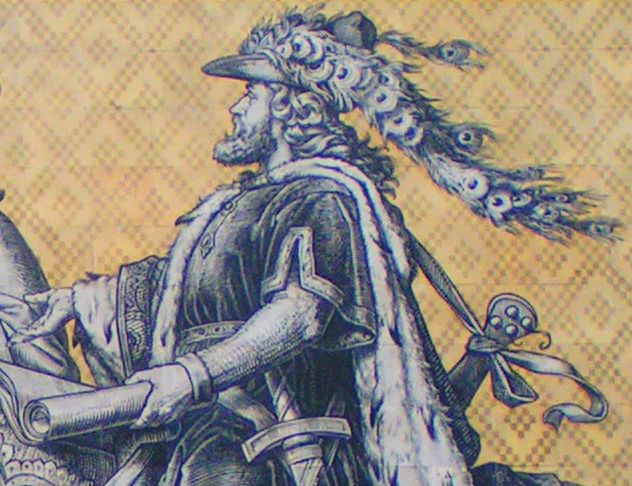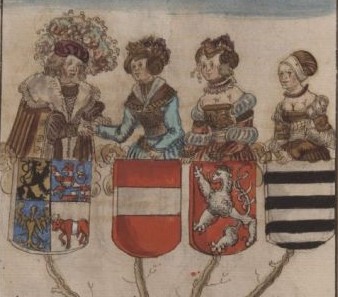Henry III, Margrave Of Meissen on:
[Wikipedia]
[Google]
[Amazon]
Henry III, called Henry the Illustrious (''Heinrich der Erlauchte'') (c. 1215 – 15 February 1288) from the
 Henry had his first combat experience in sometime around 1234, while on crusade in Prussia, fighting against the Pomesanians. His pilgrimage and company is well-documented by Peter of Dusburg, and it resulted in the construction of Balga castle, an important administrative centre for the Teutonic Knights. In 1245 after many years of conflict with the Ascanian margraves of Brandenburg, he was forced to cede the fortresses of Köpenick, Teltow and Mittenwalde north of Lower Lusatia. In 1249 however, the Silesian duke Bolesław II the Bald granted him the eastern area around Schiedlo Castle at the Oder river, where Henry founded the town of Fürstenberg.
In the struggle between the Hohenstaufen Emperor Frederick II and Pope Gregory IX, Henry took the side of the Emperor. In consideration, Frederick II in 1242 promised him the heritage of Henry Raspe as Landgrave of
Henry had his first combat experience in sometime around 1234, while on crusade in Prussia, fighting against the Pomesanians. His pilgrimage and company is well-documented by Peter of Dusburg, and it resulted in the construction of Balga castle, an important administrative centre for the Teutonic Knights. In 1245 after many years of conflict with the Ascanian margraves of Brandenburg, he was forced to cede the fortresses of Köpenick, Teltow and Mittenwalde north of Lower Lusatia. In 1249 however, the Silesian duke Bolesław II the Bald granted him the eastern area around Schiedlo Castle at the Oder river, where Henry founded the town of Fürstenberg.
In the struggle between the Hohenstaufen Emperor Frederick II and Pope Gregory IX, Henry took the side of the Emperor. In consideration, Frederick II in 1242 promised him the heritage of Henry Raspe as Landgrave of 
House of Wettin
The House of Wettin () was a dynasty which included Saxon monarch, kings, Prince Elector, prince-electors, dukes, and counts, who once ruled territories in the present-day German federated states of Saxony, Saxony-Anhalt and Thuringia. The dynas ...
was Margrave of Meissen
This article lists the margraves of Margraviate of Meissen, Meissen, a March (territorial entity), march and territorial state on the eastern border of the Holy Roman Empire.
History
King Henry the Fowler, on his 928–29 campaign against the S ...
and last Margrave of Lusatia (as Henry IV) from 1221 until his death; from 1242 also Landgrave of Thuringia.
Life
Born probably at the Albrechtsburg residence in Meissen, Henry was the youngest son of Margrave Theodoric I, Margrave of Meissen and his wife Jutta, daughter of Landgrave Hermann I of Thuringia. In 1221 he succeeded his father as Margrave of Meissen and Lusatia, at first under guardianship of his maternal uncle, Landgrave Louis IV of Thuringia, and after his death in 1227, under that of Duke Albert I of Saxony. In 1230 he was legally proclaimed an adult. Henry had his first combat experience in sometime around 1234, while on crusade in Prussia, fighting against the Pomesanians. His pilgrimage and company is well-documented by Peter of Dusburg, and it resulted in the construction of Balga castle, an important administrative centre for the Teutonic Knights. In 1245 after many years of conflict with the Ascanian margraves of Brandenburg, he was forced to cede the fortresses of Köpenick, Teltow and Mittenwalde north of Lower Lusatia. In 1249 however, the Silesian duke Bolesław II the Bald granted him the eastern area around Schiedlo Castle at the Oder river, where Henry founded the town of Fürstenberg.
In the struggle between the Hohenstaufen Emperor Frederick II and Pope Gregory IX, Henry took the side of the Emperor. In consideration, Frederick II in 1242 promised him the heritage of Henry Raspe as Landgrave of
Henry had his first combat experience in sometime around 1234, while on crusade in Prussia, fighting against the Pomesanians. His pilgrimage and company is well-documented by Peter of Dusburg, and it resulted in the construction of Balga castle, an important administrative centre for the Teutonic Knights. In 1245 after many years of conflict with the Ascanian margraves of Brandenburg, he was forced to cede the fortresses of Köpenick, Teltow and Mittenwalde north of Lower Lusatia. In 1249 however, the Silesian duke Bolesław II the Bald granted him the eastern area around Schiedlo Castle at the Oder river, where Henry founded the town of Fürstenberg.
In the struggle between the Hohenstaufen Emperor Frederick II and Pope Gregory IX, Henry took the side of the Emperor. In consideration, Frederick II in 1242 promised him the heritage of Henry Raspe as Landgrave of Thuringia
Thuringia (; officially the Free State of Thuringia, ) is one of Germany, Germany's 16 States of Germany, states. With 2.1 million people, it is 12th-largest by population, and with 16,171 square kilometers, it is 11th-largest in area.
Er ...
and Count palatine
A count palatine (Latin ''comes palatinus''), also count of the palace or palsgrave (from German ''Pfalzgraf''), was originally an official attached to a royal or imperial palace or household and later a nobleman of a rank above that of an or ...
of Saxony. In 1243 the Emperor also betrothed his daughter Margaret of Sicily to Henry's son Albert II.
Henry remained a loyal supporter of the Hohenstaufens and not before the departure of Frederick's son Conrad IV from Germany
Germany, officially the Federal Republic of Germany, is a country in Central Europe. It lies between the Baltic Sea and the North Sea to the north and the Alps to the south. Its sixteen States of Germany, constituent states have a total popu ...
did he recognise the antiking William of Holland. After the death of Henry Raspe in 1247, he enforced his rights in Thuringia by military means in the War of the Thuringian Succession against the claims raised by Sophie of Thuringia, daughter of late Landgrave Louis IV, and her husband Duke Henry II of Brabant, as well as by Prince Siegfried I of Anhalt-Zerbst. After a long drawn-out war he detached the Landgraviate of Hesse in the west and gave it to Sophie's younger son Henry, but kept Thuringia, which he granted to his son Albert II together with the Palatinate of Saxony. The Thuringian acquisition significantly increased the Wettin territorial possessions, which now reached from the Silesian border at the Bóbr river in the east up to the Werra in the west, and from the border with Bohemia
Bohemia ( ; ; ) is the westernmost and largest historical region of the Czech Republic. In a narrow, geographic sense, it roughly encompasses the territories of present-day Czechia that fall within the Elbe River's drainage basin, but historic ...
along the Ore Mountains in the south to the Harz range in the north.
From 1273 Henry was an important support to the newly elected '' Rex Romanorum'' Rudolph of Habsburg in his struggle against rivaling King Ottokar II of Bohemia. Against Bohemia he won, among other places, Sayda and Purschenstein Castle near Neuhausen,
He was known throughout the whole empire as a glittering prince, famous as a patron of the arts and a model knight, and as a significant minnesinger (not to be confused with Heinrich Frauenlob), poet and composer. Henry was patron of many tournaments and singing competitions, in which he also took part himself, and commissioned the famous '' Christherre-Chronik.'' He set to music hymns to be sung in the churches, by express permission of the pope.

Family
In 1234 Henry married Constance of Babenberg, the daughter of DukeLeopold VI of Austria
Leopold may refer to:
People
* Leopold (given name), including a list of people named Leopold or Léopold
* Leopold (surname)
Fictional characters
* Leopold (The Simpsons), Leopold (''The Simpsons''), Superintendent Chalmers' assistant on ''The ...
. Together they had two sons:
# Albert II, Margrave of Meissen (1240–1314)
# Theodoric of Landsberg (1242–1285)
As early as 1265 he attached the Imperial Pleissnerland around Altenburg, the dowry of his daughter-in-law Margaret, to the Landgraviate of Thuringia and gave both to his elder son Albert II, otherwise Albert the Degenerate. For his younger son Theodoric, Henry had created – though without imperial consent – the smaller Margraviate of Landsberg in the western part of the Lusatian lands around Leipzig. Henry kept for himself only the Margraviate of Meissen, the remaining Lower Lusatian lands, and a formal power of oversight. Only domestic disorders, caused by the unworthiness of his son Albert, clouded the later years of his reign and indeed, long after his death in 1288, led to the loss of Lusatia and Thuringia.
After the death of Constance in 1243 Henry took as his second wife Agnes (d. 1268), a daughter of King Wenceslaus I of Bohemia, and in his third marriage the daughter of a ''ministerialis
The ''ministeriales'' (singular: ''ministerialis'') were a legally unfree but socially elite class of knights, administrators, and officials in the High Middle Ages in the Holy Roman Empire, drawn from a mix of servile origins, free commoners, and ...
'', or serving knight, Elisabeth von Maltitz, who bore him Friedrich Clem (whose only daughter Elisabeth married Otto II, Prince of Anhalt-Aschersleben) and Hermann the Long.
Ancestry
References
Sources
* *14 * , - , - {{DEFAULTSORT:Henry 03 of Meissen, Margrave 1210s births 1288 deaths Margraves of Meissen Margraves of Thuringia House of Wettin German poets Medieval child monarchs People from Meissen Christians of the Prussian Crusade Minnesingers German male poets 13th-century German poets Burials at Altzella Abbey